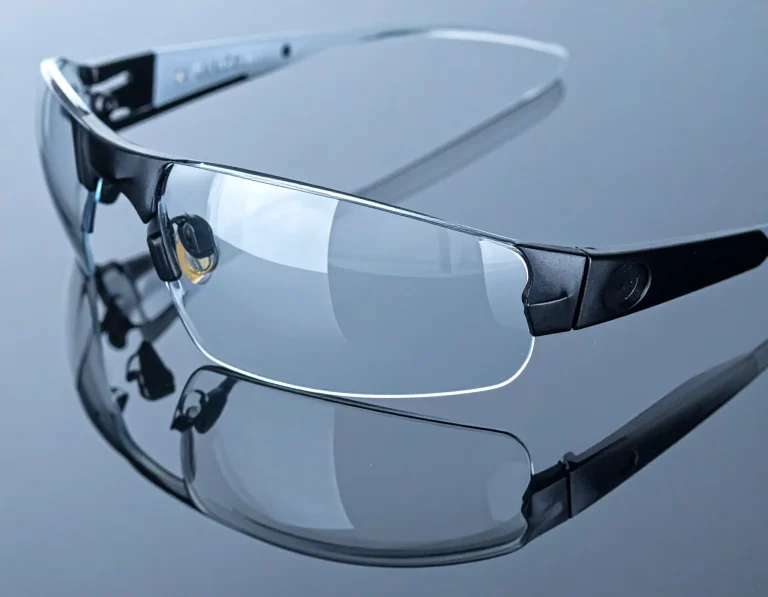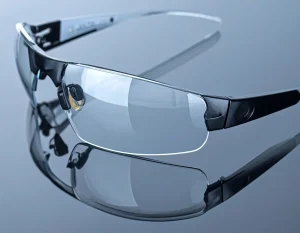Are pricier eyeglass lenses really better, and should you spend the extra money? It’s a common question, especially when the cost of a pair of prescription glasses can range widely – one Canadian study found an average range from about $240 up to nearly $1,000 for a single pair.
At first glance, budget glasses might seem like the smart choice, while high-end lenses feel hard to justify. However, price often reflects differences in lens quality, features, and service.
Not All Eyeglass Lenses Are Created Equal
All eyeglass lenses may correct your vision, but they are not all the same quality. Differences in manufacturing and options mean some lenses simply perform better and last longer. Key factors that can vary include:
- Lenses can be made from standard plastic (CR-39), glass, polycarbonate, high-index plastic, etc. Each material has unique properties affecting thickness, weight, clarity, and impact resistance. For example, high-index plastic lenses can bend light more efficiently, making them much thinner for strong prescriptions. In contrast, basic plastic lenses are thicker and less durable (though inexpensive).
- The technology used to shape and polish the lens influences visual clarity. Advanced digital or “free-form” lenses are crafted with high precision (sometimes using wavefront technology) to sharpen vision and reduce distortions, especially for complex prescriptions. Standard lower-cost lenses may use simpler designs that don’t give the same edge-to-edge clarity or personalized correction.
- Premium lenses often come with multiple coatings – anti-reflective (AR) to cut glare, scratch-resistant layers, 100% UV protection, anti-smudge or anti-fog treatments, etc. The quality and durability of these coatings vary. High-end AR coatings, for instance, reduce glare and eye strain during night driving or computer use, and they are designed to last. Cheaper lenses might skip some coatings or use basic ones that can wear off faster.
- The reputation and quality control of the manufacturer can impact lens performance. Well-known lens brands (Zeiss, Essilor, Hoya, etc.) invest in research and strict standards, often delivering more consistent clarity. Lesser-known or no-name lenses might be mass-produced with looser tolerances. In short, you often “get what you pay for” in terms of refined optics and quality assurance.
Because of these factors, a bargain pair of lenses and a premium pair can perform very differently. Your eye doctor or optician can explain these differences and help identify which lens type suits your needs. Remember: clear, comfortable vision isn’t just about the prescription numbers – it’s also about lens quality.
Budget Lenses – Basic Vision at a Lower Cost
Choosing cheaper lenses or “value” eyewear has one obvious benefit: low upfront cost. If you’re on a tight budget or only need glasses occasionally, inexpensive lenses can certainly correct your vision. In fact, even low-cost lenses will give you the essential clarity you need to see in most situations. Many people buy budget glasses online or from discount retailers for convenience – you can often get a complete pair delivered to your door for a fraction of the price of designer eyewear. For a spare pair of glasses or a quick fix, these budget options serve a purpose.
However, going cheap comes with trade-offs. Lower-priced lenses typically use basic plastic materials and minimal (if any) add-ons. You might notice these differences in daily use:
- Budget lenses are often made of standard plastic which can be quite thick and heavy if you have a strong prescription. Thicker lenses not only look bulkier but can be less comfortable due to the weight on your nose. High-index thin lenses cost more but significantly slim down coke-bottle glasses.
- Cheaper lenses often lack anti-reflective coatings, meaning you’ll see more glare from headlights, screens, or bright lights. That extra glare can be distracting and cause eye fatigue. You might even catch reflections of your own eye in the lens. Premium AR-coated lenses virtually eliminate these reflections for a sharper view. Without AR, images through the lens may not be as crisp, especially in challenging lighting.
- A basic lens might scratch easily or its coating may peel because the scratch-resistant layer (if there at all) isn’t high quality. You could end up replacing scratched lenses sooner, which adds cost over time. Expensive lenses tend to include tougher hard coats and often come with scratch warranties (e.g. free replacement within 1 year if they scratch). With cheap eyewear, if you drop your glasses or frequently clean the lenses, you may see wear and tear faster.
- Perhaps the most important difference is how well budget lenses maintain clarity across your field of vision. Inexpensive lenses are often not customized to factors like your precise pupillary distance or astigmatism axis as accurately. Some users report slight distortions or blur at the lens edges or needing to look through a “sweet spot” in the center. In fact, poorly crafted or misaligned cheap glasses can cause distorted vision that forces you to adjust your head position to find focus. You shouldn’t have to tilt your head or struggle to see through any part of your lens! This distortion is less common with higher-quality lenses that are ground and fitted with precision.
Cheap, ill-fitted glasses can lead to eye strain and constant adjustments. Many bargain eyewear buyers experience issues like frames sliding down the nose, improper alignment with their eyes, or just a “not right” feeling when wearing their glasses. An inadequate fit or inaccurate lens centering can cause eyestrain, headaches, or blurriness over time. For example, if the optical center of each lens isn’t perfectly aligned with your pupils (a common risk when ordering online without professional measurements), your vision can feel “off.” Similarly, off-the-rack reading glasses may help you read a menu, but they use generic settings that might not match your exact prescription in each eye – the result is subpar clarity and potential strain. In short, budget glasses are fine for basic needs, but be aware that you might be giving up comfort, visual crispness, and longevity.

Premium Lenses – What You’re Paying For
Why do some lenses cost $300, $500 or more? Premium eyeglass lenses come with upgrades in material, technology, and service that enhance your vision and wearing experience. Not everyone needs every extra feature, but for many people these upgrades make a noticeable difference. Let’s break down what usually makes high-end lenses worth the higher price tag.
Superior Lens Materials & Precision Manufacturing
One major factor in lens cost is the material. High-end lenses often use advanced plastics that offer better optics and comfort. For example, high-index plastic lenses are engineered to bend light more efficiently than standard plastic, so they can be made much thinner and lighter for the same prescription strength. If you have a strong correction (e.g. very nearsighted or farsighted), high-index lenses prevent the “bug-eyed” or “tiny eyes” look that thick ordinary lenses can cause.
They also weigh less on your face. Another premium material is polycarbonate or Trivex, which are extremely impact-resistant and light. Polycarbonate and Trivex lenses were developed for safety – they’re the same material used in astronaut helmet visors and sports goggles. As a bonus, they block 100% of UV rays and are thinner than regular plastic. These materials are ideal if you want durable glasses for an active lifestyle or for children’s glasses (where accidents happen!). While you pay more for high-index or Trivex/polycarbonate lenses, you gain in comfort, appearance, and safety.
In addition to what they’re made of, premium lenses often boast higher-precision optics thanks to better manufacturing processes. Many high-end lenses are digitally crafted, meaning a computer-controlled process grinds the lens to exact specifications tailored to your prescription and even how your eye looks through the lens in your chosen frame. This can correct for distortions and blur that standard mass-produced lenses might not address.
The result is often sharper vision, especially at the periphery of the lens and in high-prescription or progressive lenses. Think of it like the difference between a generic shoe and one custom-fitted to your foot – the custom one just works better for you. Premium progressive lenses (for multifocal needs) are a great example: higher-end “free-form” progressives provide wider clear zones and smoother transitions between distance and reading, making them easier to adapt to compared to basic (cheaper) progressive lenses.
Advanced Lens Coatings and Features
Another thing you pay for with expensive lenses is often a suite of lens treatments or coatings that enhance performance. These add-ons improve both your visual experience and the longevity of the lenses:
Anti-Reflective Coating
This is commonly recommended for almost everyone now, but it often comes standard on premium lenses (or is of much better quality on them). AR coating greatly reduces glare by canceling reflections on the lens surfaces. If you drive at night, work under bright lights, or use computers, AR coating can make a world of difference – you won’t see halos around headlights and screens will be easier on your eyes. It also makes your lenses look nearly invisible (no more white glare in photos or when people look at you). Top-tier AR coatings are more durable and may include oleophobic layers that resist smudges, so your glasses stay clearer throughout the day.
Scratch-Resistant Hard Coat
While no lens is 100% scratch-proof, expensive lenses typically include the best scratch-resistant coatings to protect against everyday wear. This means if you clean your glasses properly (with microfiber cloths, not paper towels) and store them in a case, premium lenses should stay clear and scratch-free longer. Some even come with a warranty, as mentioned – for instance, a 1-year scratch warranty is common on quality lenses. That warranty itself reflects the manufacturer’s confidence in their coating.
UV Protection
Ultraviolet protection might be built into the lens material (polycarbonate and Trivex inherently have it), or added as a coating on other lenses. Quality lenses ensure full UVA and UVB protection for your eyes – something you definitely want for long-term eye health. Cheaper plastic lenses might not block UV unless a coating is added. Always check that your lenses are UV400 or “100% UV” if you spend time outdoors.
Photochromic Technology
These are the “transition” lenses that darken in sunlight and go clear indoors. Photochromic lenses (like Transitions™ brand) add convenience so you don’t need a separate pair of prescription sunglasses. They do add to cost, and the branded versions tend to perform better (faster change, darker in sun) than off-brand photochromics. If you value this 2-in-1 functionality, the extra cost may be worth it – just know that inexpensive glasses typically don’t include this feature.
Polarized Sun Lenses
If you’re buying prescription sunglasses, higher cost usually gets you polarized lenses that cut harsh glare (for example, glare off water or pavement). Polarized lenses provide more comfortable vision in bright conditions than standard tinted lenses. They’re a premium feature you pay for, but for drivers, boaters, or anyone sensitive to glare, they’re often worth every penny for the increase in visual comfort and safety.
Blue Light Filtering
Some modern lenses include a filter for high-energy blue light from screens. Premium lens makers have developed clear blue-filter lenses that reduce potential digital eye strain without the deep yellow tint older blue blockers had. This is somewhat optional (the science on blue light and eye health is still evolving), but if you spend long hours on computers, you might consider it. Budget glasses may offer a basic “blue block” coating at extra cost, but the more expensive brands often have more advanced coatings that selectively filter blue light while maintaining excellent clarity.
When you opt for a premium lens package, many of these enhancements are bundled in. By contrast, if you try to add them à la carte to a budget lens, the total price might climb close to the premium anyway – but you still might not get the same quality of material or manufacturing.
These features exist to tailor lenses to your life: reducing glare, resisting scratches, tinting outdoors, etc. If some of them align with your needs (say you drive a lot at night, or you work at a computer all day), then paying more for lenses that include those benefits makes a lot of sense. It can mean the difference between end-of-day eye fatigue and comfortable vision.
Personalized Fit and Expert Craftsmanship
When you buy expensive lenses from an optical professional, part of what you’re paying for isn’t just the plastic in the lenses – it’s the expert fitting and customization that come with them. Proper fit is crucial for getting the best vision from your glasses, and this is an area where online or cheap purchases often fall short.
An optician will take precise measurements, such as your pupillary distance (PD) and the optical center height for the specific frames you choose. They’ll also consider how the frame sits on your face. With progressive or multifocal lenses, they measure segment heights and other details. These measurements ensure the lenses are positioned exactly where your eyes look through them. A well-fitted pair of glasses supports healthy, comfortable vision – reducing the risk of eyestrain or headaches that can come from improper lens alignment.
Premium eyewear is often matched to your unique facial measurements, giving a seamless fit that budget, one-size-fits-most glasses may not provide. If you’ve ever worn glasses that constantly slipped down or had to perch them at a certain angle to see clearly, you know how important fit is. Premium lenses purchased through an optometrist’s office usually include adjustments to your frames and lenses until they sit just right.
Additionally, high-end lens providers often use refined craftsmanship in lens finishing. The edges might be polished, coatings perfectly applied, and the lens cut to fit your frame with precision. There’s also typically a quality check to ensure the prescription is exactly on target. With cheaper glasses (especially online retailers or fast mass production), there’s a higher chance of small errors – perhaps the lenses are 1-2 mm off center, or the frame isn’t adjusted to hug your nose properly.
These seemingly tiny issues can noticeably affect your vision and comfort. In contrast, experienced opticians literally “fine-tune” premium glasses for you. As a result, when you put on a well-made, well-fitted premium pair, you should see clearly across the entire lens without needing to adjust or struggle. The glasses should feel comfortable and stable, almost like an extension of your face. That level of comfort and confidence in your eyewear is a big part of the value of paying more.
Finally, don’t overlook the customer service and support element. If you invest in expensive lenses from a reputable optical shop, you usually gain ongoing support: free adjustments, cleanings, and hassle-free warranty service if something goes wrong.
Many premium brands back their lenses with solid warranties, offering repairs or replacements if a coating peels or a lens cracks unexpectedly. In comparison, an online budget retailer might only offer 30 days to return or a limited warranty that’s hard to use. The peace of mind that your investment is protected can be significant. After all, glasses are an everyday tool for your quality of life – knowing that you can get them fixed or replaced easily if needed is part of the premium experience.
Durability and Long-Term Value
Let’s talk about the long game: Are expensive lenses actually a better investment over time? Often, yes. High-quality materials and coatings mean the lenses will maintain clarity for longer, so you won’t need to replace them as frequently due to scratches or damage. For example, if a $100 pair of glasses gets scratched up every year, you’ll spend $200 replacing them in two years. But a $300 pair with durable, scratch-resistant lenses might last you 3 – 5 years before you even think about a replacement. Over time, the premium option can be more cost-effective.
Moreover, consider how long you can use a given pair of glasses. Frames styles come and go, but many people keep a classic, well-made frame for several years and just update the lenses when their prescription changes. If you invest in good lenses now, you may be able to simply have new lenses made for your nice frame in the future, rather than buying a whole new set of glasses. There are even services that will put new lenses in your existing frame (some optical shops or specialized lens companies offer this). The most cost-effective strategy is often to buy moderately priced, sturdy frames and put the best lenses you can afford in them, then update the lenses as needed. That way, you’re spending on what matters most – the part that helps you see.
Also, higher-end lenses often come with those warranties we mentioned. For instance, many optical retailers include a one-year or even two-year lens warranty against scratches or defects when you purchase premium lenses. If your lenses scratch badly in that period, they’ll replace them at no charge. That warranty adds value and effectively extends the life of your purchase. Cheap online glasses rarely offer such a guarantee (perhaps a short 30-day window), so if they scratch, you’re on your own. Warranties are only as good as the retailer behind them – can you trust a random cheap online seller to still be around to honor a problem? With a reputable provider, you can. Knowing your glasses are protected means your investment in expensive lenses is less risky.
From a vision standpoint, premium lenses can also protect your eyes better, potentially saving you costs related to eye strain or accidents. For example, polycarbonate or trivex lenses (though more expensive than basic plastic) could save your eyes from injury if you get hit in the face, because they won’t shatter. Quality sunglasses lenses that block all UV light might help prevent sun-related eye conditions down the line. These are hard benefits to put a dollar value on, but they contribute to the long-term payoff of quality eyewear.

Are Expensive Lenses Worth It for You? Factors to Consider
After weighing the differences, it’s clear that expensive lenses offer superior quality – but they also cost more. So, is it worth it for you to spend the extra? The answer depends on several personal factors. Consider the following when making your decision:
Your Prescription & Visual Needs
Do you have a strong prescription or specialized needs (bifocals, astigmatism, etc.)? If you have a very high prescription or a complex vision issue, investing in higher-quality lenses can provide noticeably sharper and more comfortable vision than basic lenses.
For example, if you’re extremely nearsighted, high-index lenses will reduce thickness and distortion. If you require progressive lenses, premium versions will likely give you a wider clear field of view and faster adaptation. On the other hand, if your prescription is mild and straightforward, you might see just fine with standard lenses and not notice a big improvement with premium options.
Lens Features You’ll Use
Think about which lens features matter to your lifestyle. Do you often drive at night or have a lot of screen time? Then anti-reflective coating is probably worth it for you. Spend lots of time outdoors? Photochromic or polarized sunglasses lenses might be very valuable. If you realize you do need several add-ons (AR, scratch coat, etc.), then a premium lens package that includes all of them is worth the cost. Conversely, if you only need single-vision glasses for occasional use and none of the fancy extras, a budget pair might serve you perfectly well.
Comfort & Wear Time
How much do you rely on your glasses? If you wear them all day every day, the comfort factors (lightweight material, good fit, no distortion) are extremely important. Small annoyances become big when you deal with them 16 hours a day. Many people who wear glasses full-time feel that spending more for premium lenses is a worthwhile investment in daily comfort and clear vision – it affects your quality of life every waking minute. If you only put glasses on briefly (say, for reading or driving), you might be more tolerant of minor issues in a cheaper pair.
Durability vs. Replacing
Are you okay with glasses that might scratch or need replacing more frequently? Some people churn through cheap glasses yearly due to breakage or wear. Others prefer to buy one solid pair that will hold up. If you tend to be rough on your glasses or use them in tough conditions (construction work, lots of travel), premium lenses with tough coatings and good warranties will likely save you money and hassle long-term. But if you’re someone who keeps their glasses in a case and is very careful, you might manage with less expensive lenses without too many issues (though scratching can happen to anyone!).
Budget and Insurance
Of course, budget is a real concern. If cost were no object, we’d probably all choose the top-tier lenses for peace of mind. In reality, you have to balance what you can afford. Check if your vision insurance covers a portion of premium lenses – many plans will cover basics and you pay the upgrade difference. Also consider that you don’t necessarily need every upgrade. A good strategy is to spend on the features that give you the most benefit.
For instance, you might choose a mid-level lens material but absolutely get the AR coating and a good scratch warranty. Talk to your optician about your budget; they can often suggest where to invest and where you might save. Remember that your lenses are the part actually correcting your vision – if cutting costs, it’s often advised to prioritize lens quality over frame brand names.
Brand Preference & Trust
Some people simply feel more confident with certain brand-name lenses (like “I only want Essilor’s Varilux progressives because they’ve worked for me before,” or “I trust Zeiss coatings for their clarity”). Branded lenses can be more expensive, but if that reputation matters to you, it might be worth it. The flip side is that expensive doesn’t always equal best – there are lesser-known manufacturers with high quality too. However, generally the brands known for quality have earned that by delivering reliable products. If having that assurance of quality helps you sleep at night, it may justify spending a bit more.
Ultimately, determining worth comes down to value for your specific needs. Ask yourself: What problems or annoyances do I want my glasses to solve? If premium lenses solve issues that you struggle with (blurriness, glare, heavy glasses, etc.), then they are likely worth the money. If you’ve used inexpensive glasses before and had no complaints, you might not gain as much from upgrading. It’s a personal equation of cost vs. benefit.
An experienced eye care professional can also provide guidance by explaining the differences and letting you “test drive” lens options (for example, demonstrating with sample lenses or testimonials). Don’t hesitate to discuss these considerations during your eye exam or eyewear shopping. The goal is to get glasses that you’re happy with and that protect your vision. As one doctor-put it, your lenses are an investment in clear vision over the long term – only you can decide how much that’s worth, but being informed will help you make the best choice.

The Bottom Line: Clarity vs. Cost
So, are expensive glasses lenses worth it? In many cases, yes – quality lenses can be a smart investment in your vision. They can deliver sharper sight, greater comfort, and longer-lasting durability, which all contribute to better day-to-day life with glasses. When you consider how vital your eyesight is, paying more for reliable, high-performance lenses (especially for all-day wear or complex prescriptions) often pays dividends in ease and satisfaction. As the saying goes, “the bitterness of poor quality remains long after the sweetness of low price is forgotten.” Many people who switch to premium lenses notice the difference immediately in visual clarity and comfort, and they don’t want to go back to the bare-bones options.
That said, “worth it” depends on you. If your needs are simple and your budget is limited, you can absolutely get by with affordable glasses – just have realistic expectations about their performance. There are also middle-ground options that balance cost and quality, so you might not need the most expensive lenses to get what you need.
The good news is that you have more choices than ever, from bargain online eyewear to ultra-customized optics. Consider the factors we discussed: your prescription complexity, desired features, usage pattern, and long-term outlook. Think about what bothers you with past glasses and what you value most (be it crystal-clear vision, featherlight comfort, extra durability, etc.). Investing a bit more upfront might save you frustration and money later on.
If you’re still unsure, the best step is to consult with an eye care professional who knows the latest lens technologies and can make personalized recommendations. At Premier Optical, we’re happy to walk you through the options – from budget-friendly solutions to top-of-the-line lenses – and find the right match for your eyes and wallet. Our priority is that you see your best and feel confident in your eyewear choice.
Remember, the true value of a lens isn’t just its price tag, but how well it works for you. By doing your research (reading guides like this and asking questions), you’re already on the right path. In the end, whether you choose expensive lenses or not, being informed will ensure you get the best value for clear, healthy vision. Your eyes are worth it!












